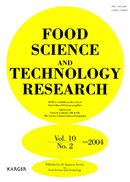Volume 10, Issue 2
Displaying 1-26 of 26 articles from this issue
- |<
- <
- 1
- >
- >|
Review
-
2004Volume 10Issue 2 Pages 103-110
Published: May 25, 2007
Released on J-STAGE: August 28, 2008
Download PDF (1041K)
Food Technology and Engineering
Original papers
-
2004Volume 10Issue 2 Pages 121-126
Published: May 25, 2007
Released on J-STAGE: August 28, 2008
Download PDF (608K) -
2004Volume 10Issue 2 Pages 227-231
Published: May 25, 2007
Released on J-STAGE: August 28, 2008
Download PDF (15914K)
Food Science and Chemistry
Technical papers
-
2004Volume 10Issue 2 Pages 186-190
Published: May 25, 2007
Released on J-STAGE: August 28, 2008
Download PDF (643K) -
2004Volume 10Issue 2 Pages 208-213
Published: May 25, 2007
Released on J-STAGE: August 28, 2008
Download PDF (667K) -
2004Volume 10Issue 2 Pages 214-217
Published: May 25, 2007
Released on J-STAGE: August 28, 2008
Download PDF (435K)
Original papers
-
2004Volume 10Issue 2 Pages 111-113
Published: May 25, 2007
Released on J-STAGE: August 28, 2008
Download PDF (363K) -
2004Volume 10Issue 2 Pages 114-120
Published: May 25, 2007
Released on J-STAGE: August 28, 2008
Download PDF (829K) -
2004Volume 10Issue 2 Pages 127-131
Published: May 25, 2007
Released on J-STAGE: August 28, 2008
Download PDF (990K) -
2004Volume 10Issue 2 Pages 132-136
Published: May 25, 2007
Released on J-STAGE: August 28, 2008
Download PDF (704K) -
2004Volume 10Issue 2 Pages 137-142
Published: May 25, 2007
Released on J-STAGE: August 28, 2008
Download PDF (626K) -
2004Volume 10Issue 2 Pages 147-151
Published: May 25, 2007
Released on J-STAGE: August 28, 2008
Download PDF (607K) -
2004Volume 10Issue 2 Pages 152-156
Published: May 25, 2007
Released on J-STAGE: August 28, 2008
Download PDF (458K) -
2004Volume 10Issue 2 Pages 164-167
Published: May 25, 2007
Released on J-STAGE: August 28, 2008
Download PDF (466K) -
2004Volume 10Issue 2 Pages 168-173
Published: May 25, 2007
Released on J-STAGE: August 28, 2008
Download PDF (740K) -
2004Volume 10Issue 2 Pages 174-179
Published: May 25, 2007
Released on J-STAGE: August 28, 2008
Download PDF (768K) -
2004Volume 10Issue 2 Pages 180-185
Published: May 25, 2007
Released on J-STAGE: August 28, 2008
Download PDF (922K) -
2004Volume 10Issue 2 Pages 191-194
Published: May 25, 2007
Released on J-STAGE: August 28, 2008
Download PDF (481K) -
2004Volume 10Issue 2 Pages 195-198
Published: May 25, 2007
Released on J-STAGE: August 28, 2008
Download PDF (550K) -
2004Volume 10Issue 2 Pages 199-204
Published: May 25, 2007
Released on J-STAGE: August 28, 2008
Download PDF (618K) -
2004Volume 10Issue 2 Pages 218-223
Published: May 25, 2007
Released on J-STAGE: August 28, 2008
Download PDF (783K)
Notes
-
2004Volume 10Issue 2 Pages 143-146
Published: May 25, 2007
Released on J-STAGE: August 28, 2008
Download PDF (462K) -
2004Volume 10Issue 2 Pages 157-160
Published: May 25, 2007
Released on J-STAGE: August 28, 2008
Download PDF (506K) -
2004Volume 10Issue 2 Pages 161-163
Published: May 25, 2007
Released on J-STAGE: August 28, 2008
Download PDF (384K) -
2004Volume 10Issue 2 Pages 205-207
Published: May 25, 2007
Released on J-STAGE: August 28, 2008
Download PDF (391K) -
2004Volume 10Issue 2 Pages 224-226
Published: May 25, 2007
Released on J-STAGE: August 28, 2008
Download PDF (377K)
- |<
- <
- 1
- >
- >|
